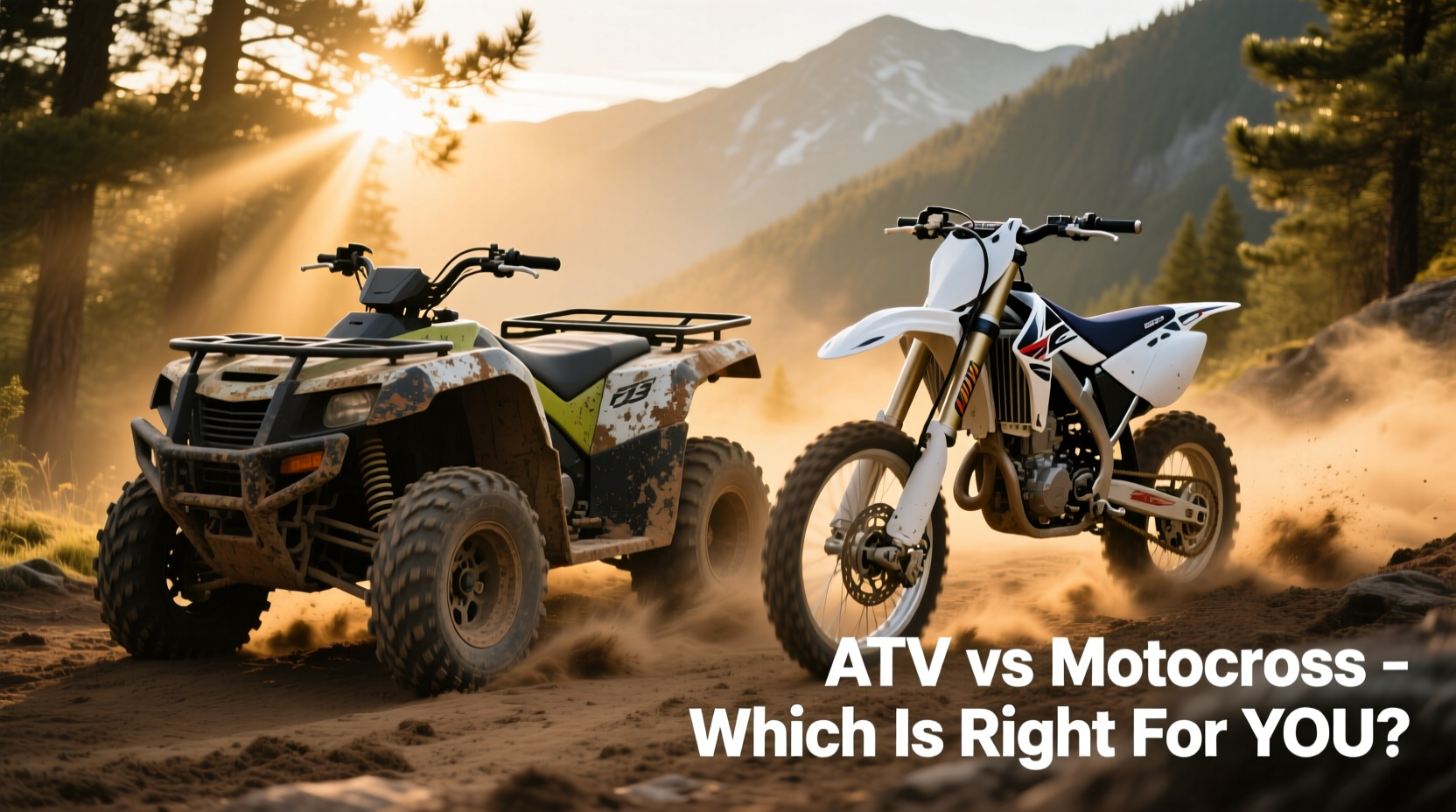Choosing between an ATV (All-Terrain Vehicle) and a motocross bike isn’t just about preference—it’s about matching your lifestyle, riding goals, and experience level with the right machine. Both deliver adrenaline-pumping off-road experiences, but they serve different purposes, require distinct skill sets, and come with unique trade-offs. If you’re limited to owning just one, the decision becomes even more critical. This guide breaks down the real-world differences so you can pick the vehicle that aligns with how—and why—you ride.
Performance and Terrain Capabilities

When it comes to conquering rough ground, both ATVs and motocross bikes excel in different ways. ATVs are built for stability and utility. Their four-wheel design provides superior traction on loose soil, mud, sand, and steep inclines. The low center of gravity makes them less prone to tipping, especially when carrying gear or pulling trailers. They’re ideal for trail riding, hunting trips, farm work, or hauling supplies across rugged property.
Motocross bikes, on the other hand, are engineered for speed, agility, and airtime. With lightweight frames and powerful two-stroke or four-stroke engines, they dominate technical terrain like rocky hills, tight woods, and jumps. Their suspension systems absorb high-impact landings, making them perfect for riders who crave racing, freestyle tricks, or aggressive trail carving.
Safety, Accessibility, and Learning Curve
Safety is a major factor, especially for beginners. ATVs are generally considered safer due to their inherent stability. Riders sit astride with feet on footrests and have handlebar steering—similar to a motorcycle—but the four wheels reduce the risk of flipping over. Many models include roll bars and seat belts, adding another layer of protection.
However, ATVs can still be dangerous at high speeds or on uneven terrain. According to the U.S. Consumer Product Safety Commission, thousands of ATV-related injuries occur annually, often due to operator error or excessive speed.
Motocross bikes demand significantly more physical coordination and balance. New riders face a steeper learning curve. Dropping a 250-pound bike mid-trail is common, and recovery requires strength and technique. But mastering a dirt bike builds exceptional core control, reflexes, and confidence. Protective gear—helmet, chest protector, boots, gloves, and knee/shin guards—is non-negotiable.
“Learning to ride a motocross bike teaches discipline and body awareness faster than almost any other motorized sport.” — Jason Reed, Professional Off-Road Trainer
Cost Comparison: Purchase, Maintenance, and Longevity
Initial price is just the beginning. Here's a realistic breakdown of ownership costs over five years:
| Category | ATV (Average) | Motocross Bike (Average) |
|---|---|---|
| Purchase Price | $5,000 – $12,000 | $7,000 – $9,500 |
| Insurance (Annual) | $150 – $300 | $200 – $400 |
| Maintenance (Yearly) | $300 – $600 | $800 – $1,500 |
| Tires/Tracks Replacement | Every 2–3 years (~$400) | Every 50–80 hours (~$300) |
| Storage/Transport | Trailer or truck bed | Motorcycle trailer or truck |
| Total 5-Year Estimate | $7,000 – $15,000 | $12,000 – $18,000 |
While ATVs typically cost more upfront, motocross bikes incur higher ongoing maintenance. Frequent chain adjustments, air filter cleaning, clutch replacements, and suspension tuning add up quickly. Tires wear faster under aggressive riding, and engine rebuilds may be needed after heavy track use.
Real-Life Scenario: Choosing Based on Lifestyle
Meet Sarah, a 34-year-old wildlife biologist living on a 40-acre rural property. She initially wanted a motocross bike for weekend fun but realized her needs were practical: checking fence lines, transporting equipment, and occasionally giving her kids rides. After test-driving both, she chose a mid-sized ATV with cargo racks and winch capability.
“I love the idea of motocross,” she said, “but I’d never have time to maintain it properly or ride it enough to justify the cost. My ATV gets used twice a week for real tasks—and we still have fun on trails together as a family.”
Contrast this with Mark, a 22-year-old mechanical engineer who grew up riding dirt bikes. He lives near public motocross parks and competes occasionally. He opted for a 250cc four-stroke motocross bike. “The physical challenge, the precision—it’s like a sport. An ATV feels like a lawn tractor compared to this.”
Their choices weren’t about which vehicle is “better” overall, but which fits their daily reality.
Checklist: Which Off-Road Vehicle Is Right for You?
Answer these questions honestly before deciding:
- Do I need to carry passengers, gear, or tools regularly? → Favors ATV
- Am I primarily riding for recreation or competition? → Favors Motocross
- Do I have prior motorcycle or dirt bike experience? → Favors Motocross
- Is my terrain muddy, rocky, or steep? → ATV handles mud better; motocross excels on rocks and climbs
- Do I want to involve family members or kids in riding? → ATV allows side-by-sides or rear seats
- Can I commit 2+ hours per month to maintenance? → Motocross demands more attention
- Will I store it indoors or exposed to weather? → Motocross bikes degrade faster outdoors
Step-by-Step Decision Guide
- Define your primary use: Work, family recreation, racing, trail exploration?
- Assess your riding experience: Beginner riders benefit from ATV stability.
- Test ride both: Rent or borrow before buying. Notice comfort, control, and fatigue levels.
- Calculate total ownership cost: Include insurance, fuel, parts, and storage.
- Evaluate local access: Are there motocross tracks nearby? Are ATV trails legal in your area?
- Consider long-term value: ATVs tend to hold resale value better due to versatility.
- Make your choice: Align the vehicle with your actual usage, not fantasy scenarios.
Frequently Asked Questions
Can a beginner safely ride a motocross bike?
Yes, but with caveats. Beginners should start with smaller displacement models (e.g., 125cc two-stroke or 250cc four-stroke), take professional lessons, and practice in controlled environments. Without proper training, motocross bikes can be overwhelming and dangerous.
Are ATVs allowed on public roads?
In most U.S. states, ATVs are not street-legal unless modified and registered as ORVs (Off-Road Vehicles). Some rural areas allow limited road use with permits, but always check local regulations before riding on paved surfaces.
Which is faster—ATV or motocross bike?
Motocross bikes are significantly faster in terms of acceleration and top speed on off-road courses. While some ATVs can reach 70+ mph, motocross bikes achieve similar speeds with greater agility and handling precision, making them feel much quicker in real-world trail conditions.
Final Recommendation: It Depends on Your Purpose
If you're looking for a do-it-all machine that supports chores, family outings, and casual trail riding, the ATV is the smarter, more versatile investment. Its ease of use, load capacity, and forgiving nature make it accessible to a wider range of riders.
If you're drawn to athleticism, speed, and the thrill of mastering a high-performance machine, and you’re willing to invest time and money into maintenance and skill development, a motocross bike will deliver an unmatched riding experience.









 浙公网安备
33010002000092号
浙公网安备
33010002000092号 浙B2-20120091-4
浙B2-20120091-4
Comments
No comments yet. Why don't you start the discussion?